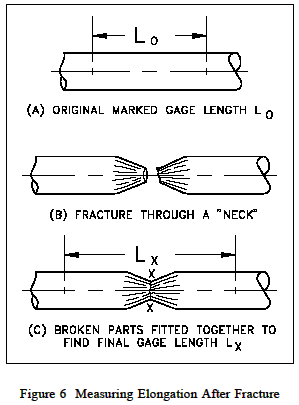Ductility
Ductility is a measure of how much deformation or strain a material can withstand before breaking. The most common measure of ductility is the percentage of change in length of a tensile sample after breaking. This is generally reported as % El or percent elongation. The R.A. or reduction of area of the sample also gives some indication of ductility.
Ductile materials show large deformation before fracture. The lack of ductility is often termed brittleness. Usually, if two materials have the same strength and hardness, the one that has the higher ductility is more desirable. The ductility of many metals can change if conditions are altered. An increase in temperature will increase ductility. A decrease in temperature will cause a decrease in ductility and a change from ductile to brittle behavior.
Ductility is more commonly defined as the ability of a material to deform easily upon the application of a tensile force, or as the ability of a material to withstand plastics deformation without rupture. Ductility may also be thought of in terms of bendability and crushability. The percent elongation reported in a tensile strength test is defined as the maximum elongation of the gage length divided by the original gage length. The measurement is determined as shown in Figure 6.


Reduction of area is the proportional
reduction of the cross-sectional area of a tensile strength test piece at the plane of fracture
measured after fracture.

The reduction of area is reported as
additional information (to the percent elongation) on the
deformational characteristics of
the material. The two are used as indicators of ductility,
the ability of a material
to be elongated in tension. Because the elongation is not
uniform over the entire
gage length and is greatest at the center of the neck, the
percent elongation is not an absolute
measure of ductility. (Because of this, the gage length must
always be stated when the percent
elongation is reported.) The reduction of area, being
measured at the minimum diameter of
the neck, is a better indicator of ductility.
Ductile
materials show large deformation before fracture. The lack of
ductility is often termed brittleness.
Usually, if two materials have the same strength and
hardness, the one that has the higher
ductility is more desirable. The ductility of many metals can
change if conditions are altered.
An increase in temperature will increase ductility. A
decrease in temperature will cause a
decrease in ductility and a change from ductile to brittle
behavior.
Cold-working also tends to make metals less
ductile. Cold-working is performed in a temperature region
and over a time interval to obtain plastic deformation, but
not relieving the strain hardening.
Minor additions of impurities to metals, either deliberate or
unintentional, can have a
marked effect on the change from ductile to brittle behavior.
The heating of a cold-worked metal
to or above the temperature at which metal atoms return to
their equilibrium positions will increase
the ductility of that metal.
|
